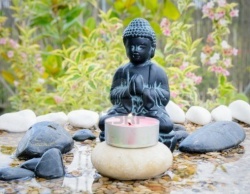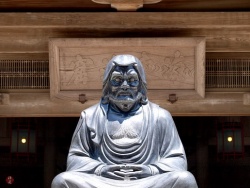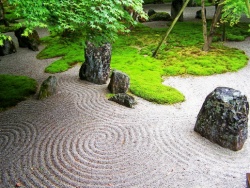The Dhyana-Samadhi Meditation Absorptions - Part 3
Methods for Attaining One-pointedness
Naturally, there are many ways to attain the four Dhyana and formless Samadhi, and certain of these methods are common to a number of different Spiritual schools. Mantra practice is one such method, as are visualization and breathing techniques. All the methods that help you concentrate on a single object fall into the category of Spiritual cultivation practices as well.
The practice of sitting Meditation is also a well-known means for cultivating the single-pointed Concentration required of Samadhi, and there are quite a variety of different physical positions you can use for Meditation practice. But the question is, of all the cultivation techniques available, why is it that sitting contemplation is the most common technique?
The principles behind the use of sitting Meditation (zazen) are very deep. In fact, they are so deep that they would require an entire book of explanations to fully cover the topic. However, with the little space we have, we can shed the following Light on the matter.
The Mind reaches Samadhi when it attains a stage of one-pointed Concentration, or absorption. Since Mind and Body are of one unity, if the Mind reaches Samadhi, the Body will be able to attain Samadhi, too, which means that its normal irritations will stop bothering us. And if we proceed conversely, in trying to maneuver our Body into Samadhi (which means that it becomes relaxed but without leaking energy), this can help our minds arrive at a state of calmness as well.
Simply put, to initially attain Samadhi requires a unity of both Body and Mind, so in stilling the Body and calming its energy flows (by detaching from them and the sensations they generate), we can speed any efforts to calm our minds. Through the stability of sitting Meditation, comforting the Body helps still the Mind for its entry into Samadhi. In other words, if we can calm the Body Consciousness, we can detach from it and achieve the Emptiness required of Samadhi Concentration.
Our bodies are used to moving around all the time and get quite restless if they are motionless for even the shortest while. That is because when are bodies are as yet unpurified or untransformed, their energy flows are not smooth. Even if we sit quietly somewhere with the intent of resting the Body, we usually find ourselves shifting positions quite frequently in order to become more comfortable, unless of course we enter some stage of Concentration wherein we end up forgetting about our bodies entirely.
Therefore, if we want to attain Samadhi, it will help to sit in a special posture that will eliminate this need for Constant shifting; if the Body can become peaceful through this special posture, then the Mind can become peaceful as well.
This is one of the principles behind sitting in special postures for Meditation practice. These special sitting positions may feel uncomfortable at first, but they help bind our energies to stay within the circuits of our bodies. Furthermore, the various saints and sages have found that once mastered, they are the best positions for eliminating the distractions of the physical nature. That is why sitting in Meditation is one of the most important positions for Spiritual practice.
Not talking-both internally and externally--also helps us to attain Samadhi, although of course, some cultivation methods require us to recite mantras. But even in these cases, your Mind should be internally listening to the Mantra without adding any extra commentary to the sounds; the only Sound experienced within Mantra practice should be the Sound of the Mantra itself rather than any internal talking. There should be no second dialogue, and you should not impose any internal Thought words of comprehension. In fact, when we are Chanting a Mantra there should not be any internal dialogue--the Mental realm within should remain quiet. As Kuan-Yin Bodhisattva taught, all you should do is use your Mind to listen. First you listen to the Sound, then to the stillness or Emptiness within, and then you forget them both to enter into Samadhi.
In the first Dhyana, the Mind and Body can enter into one-pointed Concentration because they get absorbed into one thing, one scenario. One way you can achieve this Concentration is through practicing the skeleton method contemplation wherein your whole Mind becomes absorbed in visualizing your shining white skeleton absent of muscles and flesh. You have to practice this until you reach the point that the visualization totally absorbs you and eventually becomes a Constant habit. In this way you will finally be able to achieve one-pointed Concentration.
If you entertain any other feelings or sensations during this period of absorbed Concentration, then you have lost this stage of Concentration, as you are no longer focused. That is why you may have to practice technique for awhile until you finally achieve it. Every cultivation method takes practice, but you have to make every technique a continuous habit until you are practicing that technique always.
The breathing methods of anapana are another way to develop the one-pointed Concentration required of Dhyana. They involve cultivating the Breath until it becomes so calm that the Mind and Breath unite into one. If you allow your Mind to follow other things at this stage, then you have also already departed from this technique. You must want your cultivation practice, whatever it is, to become such a solid habit that you are always within a scenario of Concentration (without a knitted brow, of course). Then you will actually be able to achieve Samadhi.
Most of the methods for attaining Samadhi require this habit of continual Mindfulness, or nien. Mindfulness means grasping a technique and sticking with it with Constant devotion, because lackadaisical or haphazard practice will not produce anything substantial in terms of Spiritual attainments. Without Mindfulness, you will make very little Spiritual accomplishment whatsoever despite what you may believe. You will just go through the motions of practice for years without ever tasting any of the fruits of attainment.
Chanting The Buddha's name, or another Mantra and even the rosary, are also popular means of reaching the scenario of single-minded Concentration. But even though all these methods are really available, who is actually able to enter into Samadhi? Not many people today. And why? Because people easily give in to distractions and do not maintain the required continuous effort of practice. When the phone rings, they interrupt their practice and fail to get started again. They let hunger or the desire to see a movie override their practice time. If they have to prepare for work tomorrow, they put their practice aside.
There are many other excuses people use ... there is always some bad Karma which people let get in the way of their Spiritual practice efforts, and thus, the achievement of genuine Spiritual progress is always a hope rather than a reality.
Think of a time when you were clear-minded and calm. Were you able to constantly maintain that scenario at all times whether you were lying, walking, sitting, standing, or whether you were experiencing a good time or were in the midst of a difficult situation? Not many people can do that, which is why a lot of people give up the World for a while in order to cultivate Samadhi. They hope by getting away from the distractions of the World, they can full-heartedly devote themselves to the effort of cultivating Dhyana.
In Esoteric Buddhism, there are a variety of cultivation practices whose intent is to actually keep you so busy that you cannot help but remain in a Concentration scenario to complete the tasks they set, and so you thereby enter Samadhi in this way. They ask you to simultaneously ring a Bell, recite a Mantra, visualize some particular scenario, and move you hands in peculiar mudras, or hand gestures. They put a thousand demands on your Concentration so that you become completely absorbed in what you are doing, and then get so tired that you finally give them all up to attain an empty Mental state.
This is the intent of their own particular method for leading you into Samadhi. It is a way of tricking you into the desired realm of Concentration because the practices are not the important thing in themselves. They are not the holy thing, but just a means of overloading your Mental abilities so that you develop a sharp single-minded Concentration, or abandon everything to attain Emptiness. In either way, you end up with Concentration. Unfortunately, people lose sight of this fact and take the actual ceremony for the important thing, which is just one of the problems inherent in the Esoteric school of today.
The stark simplicity of a Zen tea ceremony has the same goal and intention, so you must remember that any ceremony and its aesthetics are not really the important thing. Rather, the state of single-mindedness that is intended to be produced is the important thing, and whether or not you attain it is the measure as to whether the ceremony is successful. Therefore, no matter what cultivation method or technique you follow, you must practice for Samadhi attainments if you want to achieve the highest levels of Spiritual accomplishment. There is no other way.
Milarepa, Gampopa, Yeshe Tsogyel and Machig Labdron all cultivated a variety of practices to initially achieve their Samadhi, after which they devoted themselves to making it stronger and stronger until they finally had unveiled enough transcendental Wisdom to realize--to experientially see--that the Samadhi arise from within the realm of Enlightenment. Samadhi is empty already, but when they saw where this Emptiness came from--the true Emptiness-Without-Other--they were finally able to attain the true Tao. Thus, this is the normal sequence of Spiritual cultivation practice: First you work hard to attain some stage of Samadhi and then, using this basis as a foundation, you work even harder to further your cultivation attainments, and ultimately achieve the breakthrough to self-realization.
For the goal of Spiritual progress or Spiritual realization, there is no other choice than to practice some Form of Meditation to attain Samadhi. Thus, we have briefly mentioned several ways of applying the Mind so that it becomes unified into a single scenario; these are all bona fide ways to achieve the desired level of Concentration.
The book, Twenty-Five Doors to Meditation: A Handbook for Entering Samadhi, contains many more methods than we have space to go into, and you are advised to study this text if you want to understand these cultivation techniques and their relevant biophysics in detail. Just as we are doing here for the principles of cultivation, this book takes a nondenominational approach to explain, in a highly integrated fashion that references many religions, the main Spiritual techniques of cultivation. It tells why and how they work using explanations from a variety of different Spiritual schools and disciplines.
When ordinary people sit down to meditate, they might experience Samadhi Emptiness immediately at the start of their session, and yet lose it a moment later as they become distracted by all sorts of other stuff. When people follow the road of Esotericism, the same thing might happen; you might "get it" as soon as you initiate practice. However, the moment you start complicating matters by adding commentary, you lose that initial state of immediate Concentration. Other schools, such as yoga or Taoism, try to simplify things as much as possible by asking you to concentrate on the region of the third eye or the tan-tien below the belly in order to achieve Concentration. Even with such simple practices, however, it is difficult to really focus on these spots and not become distracted by anything else.
In Zen, the principle is to head directly for realizing our true self-nature, so Zen is a school of no-method. The Zen method used by great masters is simply to use expedient means that point directly to the great matter in order to help Spiritual disciples awaken. Later on, as it declined the Zen school in China started using the method of the hua-tou (or koan), where you keep concentrating on a question in order to try to attain the Samadhi of Concentration. You concentrate on a question such as "Who is this person walking, eating and calling Buddha's name?" or "Where did I come from?" or "What am I?" Since you are concentrating on a question while oblivious of all else, the intense questioning mood tends to cut through a lot of Mental chatter and can subsequently produce one-pointedness.
Tying up distractions in this way is one possible means to arrive at single-minded Concentration. The important focus of the question must therefore be to look within and try to answer "Who am I?" or "What am I?" These are the questions that most directly lead us to our true nature. Furthermore, when you adopt the hua-tou as a means of cultivation, you should always be in it because you should always be cultivating Mindfulness. The Investigation of the hua-tou must become a permanent habit just as in visualization practice, Mantra practice, or any other type of practice. It has to become a permanent habit you always carry around with you so that you are always in that particular scenario. This is the Mindfulness aspect of developing Concentration.
Naturally, this principle of Mindfulness applies across all the different cultivation methods, because in order to enter Dhyana or Samadhi you must become totally absorbed in some particular scenario, and that requires Constant Mindfulness. Without Mindfulness, you would just be engaging in just another line of Mental gymnastics. Hence, when a particular religious school wants you to follow the practice of worshipping some particular deity, you must not lose your head and think there is something ultimate about that particular deity. After all, both you and the deity have Tao, and so are fundamentally equivalent. The deity cannot give Tao to you; you have to awaken to it yourself. What you must recognize is the importance of one-pointed Concentration on the deity as the crucial point of the cultivation practice to help you attain the Tao.
This is the inherent principle behind the Bhakti yoga practice of devotion; it is irrelevant whether you worship Jesus or Krishna through Bhakti, for they are both worthy Spiritual examples and the state of Samadhi that you resultantly reach is the important thing. The rest of the stuff you use to cultivate this state just constitutes skillful expedient means--whatever it takes to get you into that unified Mental realm. If you are Hindu you use Krishna, Christian you use Jesus, Buddhist you use Buddha-it is all expedient means. When you are finally inside a scenario of single-minded Concentration that you resultantly achieve, you should forget about absolutely everything--time, space, the Body, Mind--including the particular scenario you used to enter that state!
Forget it all, drop everything and detach from your thoughts! Then you will really be "one with God," you will really be practicing the Tao, you will really start to understand the meaning of nonego and selflessness, and you will really be in Samadhi. You can describe this in a multitude of different ways, such as to say you are "cultivating Emptiness," but it is the same principle no matter how you word it. This stage is what Spiritual practice is all about. Attain that state, and then you will know this to be true. Otherwise, all these words are like useless garbage.
Whether we talk about Yeshe Tsogyel, Milarepa and Gampopa, or Machig Labdron, they had all specifically trained to achieve a unified scenario of Mind, meaning they all worked very hard to attain Samadhi. If you, yourself, cannot accomplish this feat, do not even be talking about your own genuine Spiritual growth and real Spiritual attainments. All these practitioners, and all the saints and sages, equally mastered some degree of contemplation training, because without it, they would have had no foundation of Spiritual achievements whatsoever.
When we read the Bible or some other holy text and wonder why all these past saints or prophets were so great, the reason is not because of "heavenly grace," but rather because they cultivated Samadhi attainments. Spiritual accomplishment is not a thing handed to you, but something you must work for. If you seem to be luckier than others in this respect, it is just the carry-over of karmic rewards from past-Life cultivation efforts.
Every now and then we find some individuals who do not need to practice too hard to attain Samadhi because they already have vast Prajna Wisdom and a high degree of previous cultivation attainment. The famous Sixth Patriarch of Zen, Master Hui-neng, who was the incarnation of a very ancient Buddha, did not go through this prior training because his Prajna Wisdom was already so high from so many previous lives of practice. Thus, he said to the Fifth Patriarch of Zen, Master Hung-jen, "My Mind abides in Wisdom at all times and is not separate from the self-nature. ... What (Spiritual practice) would you have me do?" Upon Enlightenment he achieved the great mirror Wisdom, which was the result of his cultivation merits.
There are all sorts of methods available for practicing to reach the one-pointed Concentration required of the various Samadhi and Dhyana. In fact, the purpose of worldly Religion is to give you these options of practice, and help get you started on their road of attainment. Another one of the important jobs of Religion--in addition to preserving these cultivation routes and continually making them available so that Spiritual aspirants have a living road of practice to rely upon--is to explain them and teach you how to tread these paths. Otherwise, a Religion is not doing its job.
Yet even though this is one of the responsibilities of Religion, sometimes the ruling powers within organized religions try to persecute and even destroy individuals who actually attain the Samadhi Spiritual states. Other times the leaders of religions are well meaning and really want to help people, but just do not know what to teach about these things because the Spiritual leaders lack any understanding themselves. When this is the case, true Spiritual cultivators can still suffer religious persecution even though their Spiritual attainments far surpass those of the established orthodoxy.
Christianity emphasizes that you should develop Samadhi Concentration through the road of prayer and giving (Offering and good works). Hinduism places particular emphasis on Bhakti yoga. The yoga schools stress various Body and breathing exercises along with special Mental contemplations. Judaism has Kaballah Meditation, Tantra has its Mantra practices and deity or Mandala visualizations, and so on it goes.
The World's Spiritual traditions champion all sorts of paths of practice, but they are commonly designed to help you become absorbed in a Mental realm of Concentration wherein you forget all your troubles and Mental Afflictions. But this is not the final objective of these Spiritual practices, for they only orient you into the initial steps of the required Spiritual practice effort.
If successfully cultivated, the initial result of all these methods is the one-pointed Concentration realm of the first Dhyana. The first Dhyana is not the sole property of any cultivation school, even though some schools make the claim that the road to Spiritual salvation is theirs alone. Unfortunately, people always think that the four Dhyana and other states of kung-fu attainment are unique to their own Spiritual sect alone when they are naturally occurring, universal, nondenominational, nonsectarian Phenomena.
Putting this mistake aside, the various schools of cultivation all agree on the need for Spiritual aspirants to achieve a Mental calm abiding marked by single-mindedness. This realization is what fuels the common use of these practices across Spiritual traditions. Faith or belief are not enough; you have to attain the states of Samadhi for true Spiritual Liberation.
When a scientist or Philosopher becomes so involved in trying to solve a problem that he or she forgets himself or herself and his or her surroundings, this too is a type of Concentration. However, it is best Thought of as an ordinary person's Samadhi because it lacks Prajna transcendental Wisdom and the absence of desire. Furthermore, it also lacks the characteristics of bliss and Joy found in the first Dhyana, which the Tibetan school refers to as physical and Mental pliancy.
Even scratching one's ears can be considered a type of Mental absorption, though it hardly qualifies as a Spiritual cultivation Samadhi. We can therefore understand that one difference between the attainment levels of various practitioners is the depth of their single-mindedness (Emptiness) and the extent of their Insight discernment (Prajna Wisdom). These are actually the appropriate measures of someone's genuine cultivation kung-fu.
Taoist tenets say, "If you achieve really deep Concentration, then even your shen enters into it." The Enlightened Chinese prime minister Kuan Tzu also said, "Your Insight reaches to such an extent that your comprehension penetrates to things not apparent." Ordinary people typically concentrate on making money, on sexual indulgence, or going after Fame that we can say they are almost insane with Concentration. This is certainly one type of unified scenario, but it is a sick one. It is certainly not the unified scenario of Spiritual cultivation.
The key points to this conversation are that (1) being unified in single-mindedness is a common principle to all cultivation schools, (2) there are various factors that inhibit entry into the Samadhi of single-minded Concentration, (3) the various Samadhi absorptions are common to all beings throughout the Universe because the principles of Mind are the same, and (4) there are a variety of techniques you can use to enter into the stage of Samadhi Concentration.
Unfortunately, many people who normally try to meditate and achieve one-pointedness just sit there sleeping or playing with thoughts rather than work on becoming mentally unified, so they cannot taste any of the Spiritual states they usually hope for. Then, since they cannot attain these states themselves, they do not believe they exist even though others report attaining them. Of course, there are even people who, out of stubbornness, will not believe in the phenomenal displays of superpowers and Siddhis that originate out of these states, even when they see them for themselves! Hence opinionatedness and stubbornness, as previously stated, are enemies to cultivation attainment.
It is hard to teach or even Interest individuals in the genuine process of Spiritual cultivation. The job of a teacher is not to actually convince you of anything, but simply open the way to help you practice. You have to generate your own motivation as to whether you will go down the road of cultivation practice, and a teacher can only help guide your way once you have made this decision.
If you do practice correctly, we promise that you will be able to produce all the results of Spiritual practice stated, and then you will be able to convince yourself of the Truth of the path. As several Zen masters explained, it was only after they had reached certain stages of attainment that they "had no more doubts," so the only proof you should accept is in your own Spiritual attainment.
There are all sorts of mistakes that ordinary people can make when it comes to Spiritual cultivation practice. For instance, even advanced practitioners typically believe that the Orthodox and Esoteric Schools of Buddhism, which represent the two great roads of Mind and Body cultivation, do not contain the same principles. However, people who hold this view simply have not studied deeply enough. For instance, these schools are definitely connected in the area of the Samadhi, or Mental absorptions. Once you understand the theory behind various Meditation techniques, and once you spend some time Thinking about their results, then you will begin to understand the cultivation path and be able to see these connections quite clearly.
Cultivation does not mean you can give up using your Mind and forget about studying entirely, for you still have to explore matters and familiarize yourself with the theory of cultivation. You must still read, study and deeply investigate Spiritual texts to comprehend everything. Theory without practice is useless; kung-fu accomplishment without understanding is useless as well. When you have understanding, Merit and the success of practice attainment, you will finally be able to enter the first Dhyana.
How much time will you require to achieve the first Dhyana? It will depend entirely upon your efforts and background. In other words, your Karma will determine how much time is required-both the Karma from your past lives and the extent of your efforts in this Life which will bring the ripening process to fruition. Remember that you are always in an ever present state of Samadhi, but simply cover it over with thoughts so as to hide it. Let go of these thoughts, however, and Samadhi will be unveiled instantly. Some people in Buddha's time attained Samadhi in as little as three days.
The Alaya Consciousness contains the seeds for all the Samadhi, as well as the seeds for your current situation, so all you have to do is cultivate to activate the seeds for the Dhyana that are already resting there in your Alaya Consciousness. They are universal states, which is why all beings can achieve them. In the process of working towards this goal, your Body will undergo various physical transformations that put you in line with this higher perfection. You will experience Joy, bliss and all sorts of other sensations because as you climb towards one-pointed Concentration, your chi and mai will transform, your kundalini will start to rise, and all sorts of internal blockages will become unstuck. These transformations are all the proper kung-fu of Spiritual practice.
When all four elements of our bodies change, it is natural that we will experience various physical sensations. However, these sensations and physical transformations are not the important thing. The important thing is that Mental Concentration will result in the Body transforming to a state much better suited for maintaining that state of Concentration, and since frictionless Emptiness is the Mind's natural state, the physical state supporting this achievement will correspond to optimal physical health. Health is a physical Phenomenon, so attaining the first Dhyana cannot be separated from cultivating the Body's jing, chi and mai. When you cultivate these to their prime, the natural result is optimal health and possible Spiritual achievements.
In Shakyamuni's time, some students needed only a matter of days or even hours to reach the state of Dhyana because their minds were simpler and uncomplicated and their Concentration was good enough. People like Milarepa and Lady Tsogyel suffered all sorts of hardships and required a longer period of time because they followed a path of Body cultivation rather than a path of pure Prajna Wisdom. Shakyamuni Buddha, in his Wisdom, rarely spoke of this route although he did explain the hard ascetic path of cultivation, for he underwent it himself. Mostly he emphasized the cultivation route of Mind rather than the Form practices of the Esoteric school.
Thus, the time it takes to achieve Awakening will depend upon your merits, your efforts, and the path you choose, as exemplified in the case of Zen master Hui-neng. Master Hui-neng, by looking into his Mind, reached Enlightenment almost instantly. Afterwards, he spent the next fifteen years in seclusion working on transforming his Body while stabilizing and deepening his Spiritual attainment.








